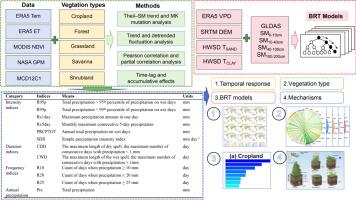当前位置:
X-MOL 学术
›
Agric. For. Meteorol.
›
论文详情
Our official English website, www.x-mol.net, welcomes your
feedback! (Note: you will need to create a separate account there.)
Identifying thresholds of time-lag and accumulative effects of extreme precipitation on major vegetation types at global scale
Agricultural and Forest Meteorology ( IF 5.6 ) Pub Date : 2024-09-24 , DOI: 10.1016/j.agrformet.2024.110239 Min Liu, Hao Wang, Huiliang Zhai, Xiaochong Zhang, Muhammad Shakir, Jianying Ma, Wei Sun
Agricultural and Forest Meteorology ( IF 5.6 ) Pub Date : 2024-09-24 , DOI: 10.1016/j.agrformet.2024.110239 Min Liu, Hao Wang, Huiliang Zhai, Xiaochong Zhang, Muhammad Shakir, Jianying Ma, Wei Sun

|
In the context of increasingly frequent extreme weather events, the temporal response of vegetation (time-lag effect and accumulative effect) to extreme climatic events is a crucial aspect of assessing vegetation dynamics under climate change. However, the contributions and thresholds of environmental factors triggering temporal responses remain unclear, which may significantly impact the assessment of the responsiveness of different ecosystems to environmental changes. Based on daily precipitation data, we evaluated the temporal effects of 11 extreme precipitation indices on the global normalized difference vegetation index (NDVI) in the 21st century and utilized the Boosted Regression Trees (BRT) model to investigate the contributions and thresholds of various factors influencing vegetation's temporal response. The results showed that: (1) although the magnitude of global heavy precipitation events had a declining trend, the amount and duration of precipitation per rainy day showed an upward trend. Spatially, China was one of the countries with the most notable increase in extreme precipitation events globally; (2) only 9.24–36.4 % of global land areas exhibited no temporal effects, the accumulative effects in the five vegetation types (cropland, grassland, forest, shrubland, savanna) collectively exceeded those of the time-lag effects (50.5–76.7 % vs 23.3–49.5 %), and the responses primarily concentrated within the first four months; (3) the temporal effects associated with 89–91 % of global NDVI were associated with heavy precipitation events (R95p and R99p), and greater precipitation frequency accentuated the prominence of temporal effects; (4) the most significant environmental factor influencing vegetation response temporally was vapor pressure deficit (VPD), with contributions ranging from 24.68 % to 47.88 %. Apart from croplands, the temporal response gradually shortened with increasing VPD in the other four vegetation types. Our study enhanced understandings of the comprehensive temporal responses of global vegetation to extreme precipitation events.
更新日期:2024-09-24






























 京公网安备 11010802027423号
京公网安备 11010802027423号